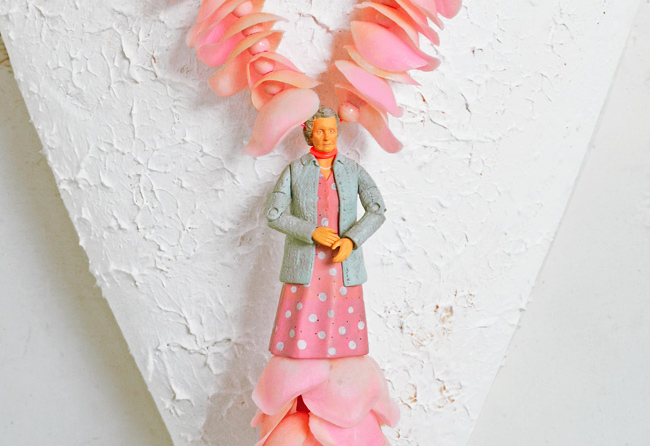
HOLY OLD DAILY LADY - Necklace, 2018 (Photo: Daniel v. Weinberger)
GREY AND SOFT PINK
HOLY OLD LADY
DAILY LADY
AS A ROSARY
OF ROSE PETALS
AROUND MY NECK
THE PREY
OF HER PRAYERS
OH
HOLY DAILY OLD LADY
danielvonweinberger.weebly.com
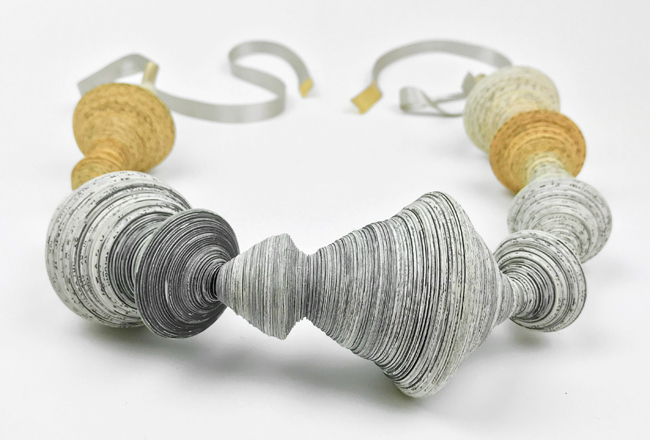
Bibliomaniac's Disc Necklace: The First Man, World of Squash, Facts of Space, 2018 (Photo: Alexandra Hopp)
"We live in a culture that wants its love affairs obsessive, its artists obsessed, its genius fixated... To be obsessive is to be American, to be modern." - from Obsession, A History by Lennard J. Davis.
Religion is outwardly marked by individual's participation in collective rituals. Did this participation in rite act as a connective medium for individuals, much like the endless check-ins with social media today? Has overwork become the new self-flagellation?
Has Obsessive-Compulsive Disorder (OCD) replaced mortification of the flesh as the process of sanctification?
It seems there is little measurable difference between religious ritual and the ritualized behavior of OCD. We have merely replaced the act of viewing the world through a religious lens for one of psychology, with little difference in the the actual behavior.
While OCD and anxiety are in the zeitgeist of modern culture, it has a long history. We see references to it in the bible, in medieval religious texts, in the description of "eccentrics" of the eighteenth century.
My work physically manifests the rituals of OCD: obsessively detailed, repetitive activities on a minute scale.
www.alexandrahopp.com
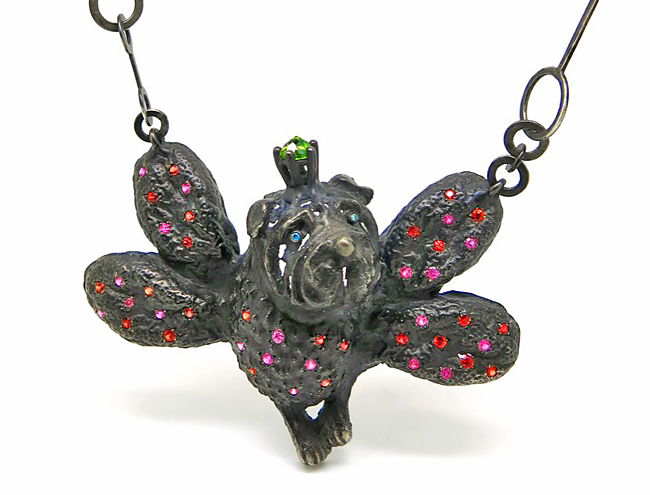
Darwins Darlings Litschimops Guido - Necklace, 2019 (Photo: Friends of Carlotta)
Our perception of technological development is linear, but actual technological progress is exponential.
Darwin's Darlings are cross-species mutations of crunchy fruits and weird animals, living in a fantasy world not so far away from our real world. Images of mice with human ears or noses growing on their backs, or experiments on pigs with human genetic material for future organ donation, are just a few examples I have encountered in my research for the Darwin's Darlings.
Is technological development as we know it, essentially nothing other than the continuation of evolution on a non-biological basis?
The silver-casted creatures reflect the apparently unlimited possibilities of genetic engineering and questions the logic of our contemporary desire for self-optimization.
The hybrid appearance of the Darwin's Darlings playfully opposes the idea of improved nature.
www.foc.ch/bruna-hauert
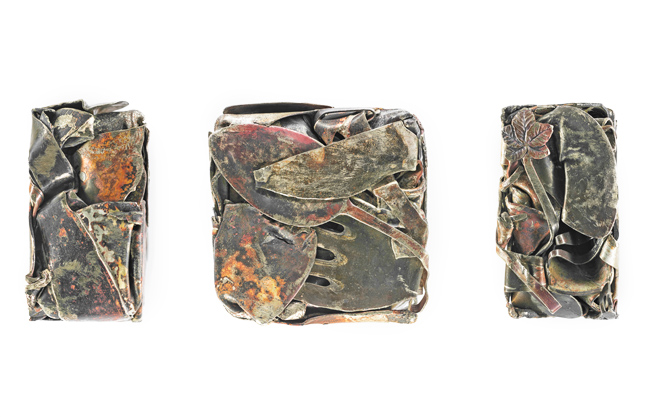
Briquets - 3 Brooches, 2019 (Photo: Konrad Jünger)
All this jewellery! All these drawers and boxes full of old chains, pendants, bracelets, rings, baptism spoons and tie pins - inherited, passed on, received as a present.
Jewellery as a hoard of decades of family history. Jewellery having no emotional value; perhaps it never had any. Costume jewellery and false feathers, the sins of a youth when everything seemed possible. Rings promising freedom.
At the end, we are left with jewellery which is feeling tired: it has been worn for a long time and now its mission is served. It is impossible to throw it away. Its material value: insignificant.
Presses make room in our world. Discarded vehicles become cute metal packages. Cubes of scrap stuck on top of each other like those in a junk yard, metal walls with idiosyncratic inner workings. Colors, memories, history.
Old jewelry has now a new form. It is compact; handy packed, pressed. Finally!
www.ludwig-menzel.de
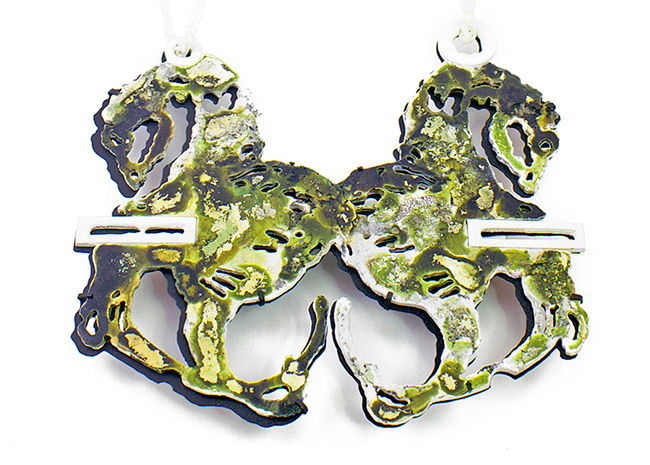
Awakening - Necklace, 2018 (Photo: Hilde Dramstad)
My series of works shows darkness and light that competes with each other, not knowing what will win in the end.
Cracks and spots insist on being part of life. We have to embrace both the darkness and the light in order to endure. A resurrection may happen. From the darkness and mistakes, new form and energy appears.
I feel in a way that when I work with my pieces of jewellery, it is sacred to me, because I put so much thoughts, love and effort in it. Nothing is indifferent with the art that I am making. The talent that every artist is given, no matter media, is sacred in its ability to communicate and even change society.
The profane is to me all the trouble and issues we are dealing with among artist such as envy, pettiness and jealousy. But also something we try to overcome, because we are not supposed to take interest in wealth and materialism.
Nothing precious and sacred about that, but in the making the qualities of the materials - plaster, asian ink, ashes and wood - rise to become something meaningful and sacred.
hildedramstad.weebly.com
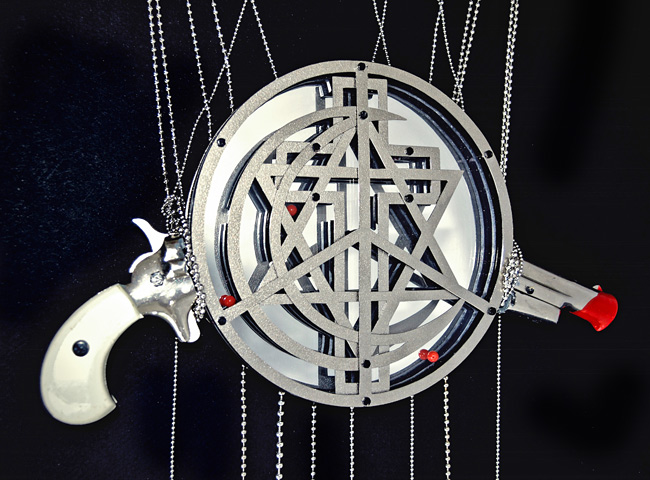
Peace Is Not A Game - Brooch, 2018 (Photo: Linda Savineau)
Through my travels I came to understand the influence of religion on all cultures. But jewelry should also be playful so I made a brooch-game or game-brooch to make my point.
Roll the little balls in the labyrinth under the intertwined symbols of the three major religions of the Western world. They will never get out, because I enclosed them under a peace sign. They are condemned to live together, to learn and to know each other and the mirror constantly reflects their image. There will be no winner, no loser , because, whatever you do, there's no way out without finding the path to peace.
IT'S UP TO YOU TO PLAY NOW!
This piece of jewelry was part of the I.M.A.G.I.N.E. Peace Now Project. 100 artists were given a disabled gun to take into their studio and transform it into a piece of art.
www.lindasavineau.com
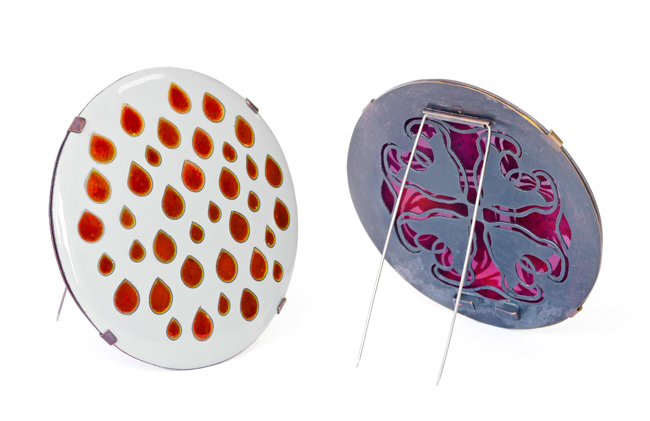
The Curse - Brooch, 2018 (Photo: Camilla Luihn)
The brooch series "On the Surface" is based on the same strict format: a convex copper disc with an ornamental pierced backside and an enameled front. By creating these "canvases" I am free to examine and process different compositions, techniques and textures which are balanced on a thin line between the intimate and "normal" and the spectacular and unusual.
The brooches can be seen as comments on contemporary beauty standards, highlighted by social media and peer pressure. As a group, they appear as a celebration of diversity, and perhaps they in some way are, but the titles gives us the key to understand and approach the pieces: “Free The Nipple”, “Pop The Cherry”, “Ikaros” etc
The inspiration for some of the pieces leans heavily on mythologic influences and values of archaic figures as symbols for modern standards.
www.luihn.no
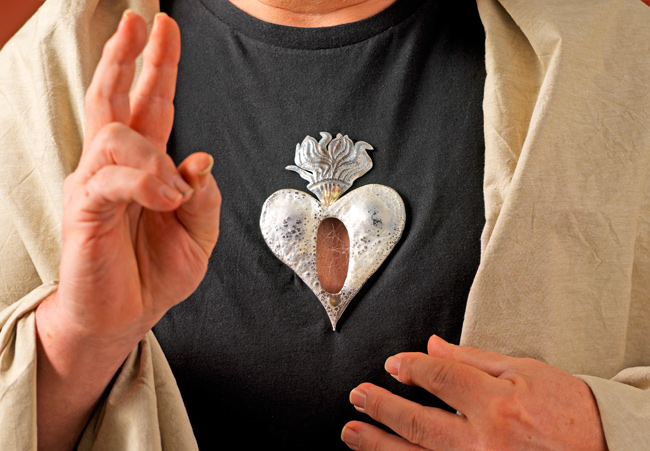
Congregation - Wearable piece, 2007 (Photo: Ria Lins)
Years beforeI made my pieces I accumulated images, impressions, sounds, smells, and feelings. The language of jewelry gave me the opportunity to share my ideas and feelings. By making them wearable, they become visible to others. I don't have to yell; I like to be present and just report.
When I created my first pieces, I was searching and exploring materials and how they move. It became a game trying to incorporate little differences and watching the transformations they bring. Today I know — more or less — what will happen if I deviate from my pattern. But surprises are still possible and fascinating, even for myself. Finding new possibilities is a source of pleasure and an opportunity to express new ideas.
Congregation is a piece that shows us how much religion and the power that's involved are close to our heart. The genesis of symbols has been ripened by century old emotions.
www.ria-lins.be
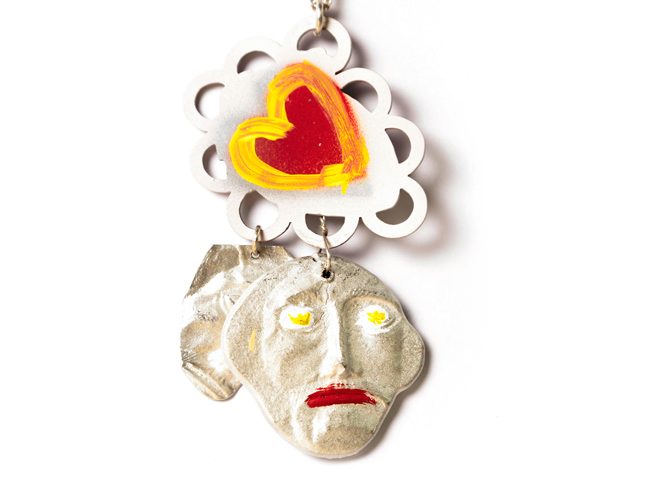
Heart Faces - Necklace, 2019 (Photo: Luke Watson)
Following my FaveLAB residency in Athens, I've been developing my interest in votives and how they can be reimagined as jewellery.
Using this framework I've developed work that considers various dynamics including votives as solidified memories, votives as anatomical representations and more recently the physical relationship between votive and icon.
Essentially, my collection for Munich 2019 serves to demonstrate the spiritual feature of "objects" and how they connect the physical to the ethereal.
With "Jewellery Objects" this connection becomes uniquely intimate!
www.annawatsonuk.com
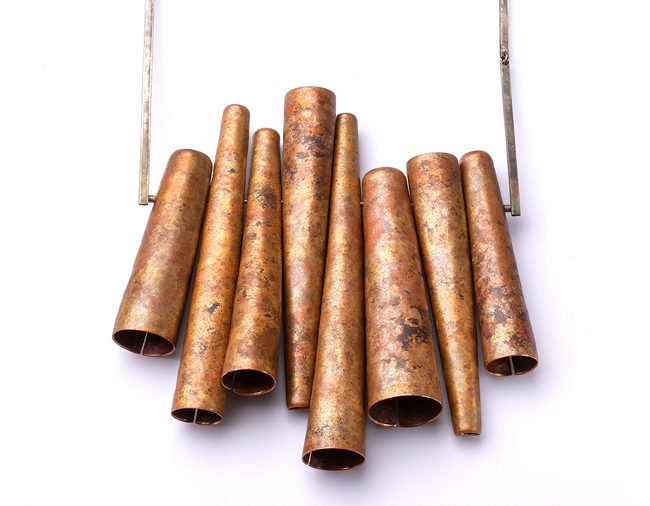
Thiasus - Necklace, 2019 (Photo: Federico Cavicchioli)
"I would believe only in a God that knows how to dance", said Zarathustra (Friedrich Nietzsche, Thus spoke Zarathustra). "For me, this God is Dionysus", Pan would reply.
Mellow and gentle, ferocious and ecstatic: Dionysus is the god of methexis, music and revelation. His worshipers follow him in a procession, celebrating and demonstrating their faith with wine, cheers, dance and music. Silenus, the satyrs and the maenads form the noisy caravan that spreads his message: the tragic fate of human existence and the process of redemption through pain. Music acts as a primary language between them, as a communication channel, as well as a means of initiation.
The "Thiasus" collection is dedicated to this heterogeneous retinue and the element that connects its members: music. The jewellery pieces are inspired by the Dionysian creatures, bringing together the ideas of human animality and artistic creation. As music provides a bridge between the believers and their God, the "Thiasus" collection aims to connect the creator and the visitor.
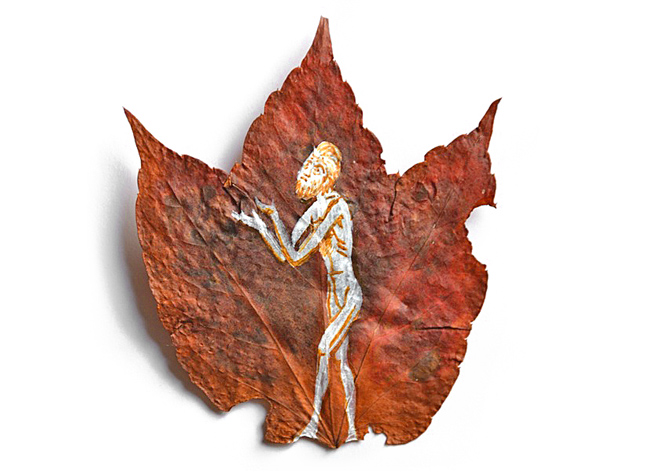
Der Heilige Basilius der Selige - Object, 2017 (Photo: Bettina Ulitzka)
My work series "Peace Of The Soul" and "Rescue Services" include a collection of accessories for-beyond-this-world, as well as handy travel essentials for the spiritual voyagers, such as "Madonna To Go".
I love the "Holy Fools" a lot. I have created a martyrology of my beloved "Saints" and painted them on dried leaves.
I find the materials I use for my art on adventure-full journeys through the darkest crypts of my sewing boxes, linen closets, kitchen drawers and in old fashioned stores in the peaceful and sleepy town of Bebra (Germany).
www.ulitzka.net
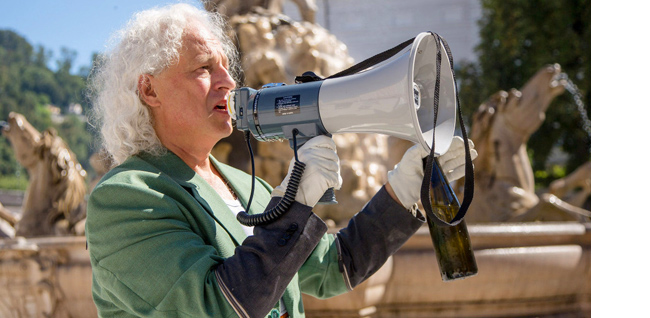
Prophescene2160 - Performance project, Salzburg 2016 (Photo: Kolarik/Rohrer)
"I trust in one word, the self-bearing inhalation through the tongue: I believe in the milky breath of the indigenous, almighty, unwilling scent of the determination.
I have faith in the fallacious coziness of mingling myths and meaning. I assert the divine destruction of this seductive cave where spirit and will become enlaced..."
Andreas Ohrenschall's "Mythophagus" (myth-eater) is a poetic strolling through semiotic patterns that divide image from meaning, word from object, "spirit" from its manifestations.
Words can be transformed into jewellery - and jewellery can become an immaterial and ephemeral vision evoked by the desire to explore the fundamental structure of language and ornament.
www.mythophagen.de
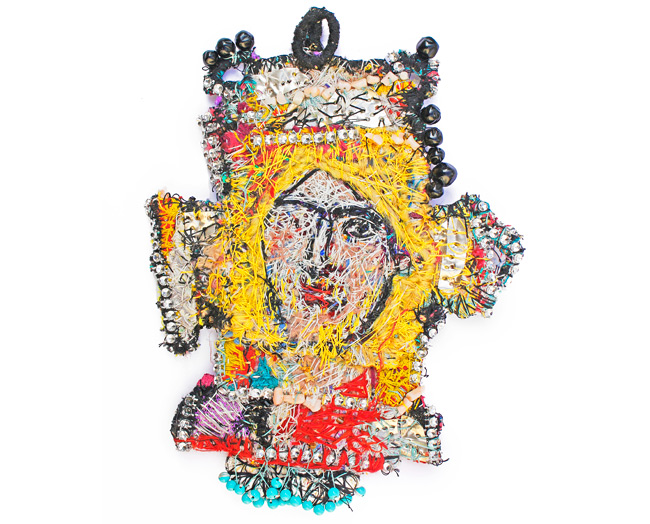
Christ pectoral after a mosaic at Daphni - Pendant, 2019 (Photo: Christoph Ziegler)
Daphni is a Byzantine monastery 11 kilometers northwest of Athens, near the Daphni -"laurel grove"- forest, on the Sacred Way to Eleusis. It was founded towards the end of the 6th century AD on the site of the Sanctuary of Apolllo desecrated by the Goths in 395. One of the four Ionic columns of the ancient Sanctuary remains at the site. The other columns were taken to London by Thomas Bruce, Earl of Elgin and are in the possession of the British Museum.
The first monastery fell into decline when Greece was severely damaged following invasions of barbarians (9th and 10th centuries). During a period of renewed prosperity (11th and 12th centuries), the Daphni Monastery was restored. The craftsmanship used in the church construction suggests emperor Basil II brought in workers from Constantinople.
The Daphni Monastery fell into decline after it was sacked by Frankish crusaders in 1205. Their Duchy of Athens was abolished in 1458 by the Turks. It is a UNESCO World Heritage Site. (Source: Wikipedia)
www.zlr-betriebsimperium.com
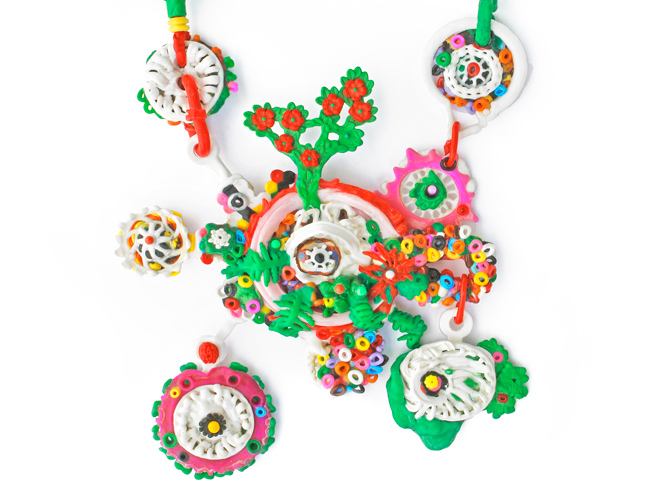
Sugar Sweet Garden - Necklace, 2019 (Photo: Christoph Ziegler)
Since the dawn of civilization, the flower has been an allegory for beauty and life. Our ambivalence between the perfection of nature and the fugacity of existence finds no clearer expression than in the image of the flower.
In Greece, the blooming spring gave birth to innumerable myths and rituals celebrating resurrection and set the fundaments of religious concepts that still prevail today.
When we think of consumption, overproduction, environmental pollution and climate destruction, the recycling of this image seems trivial. Plastic, synthetic and virtual materials replace nature's work.
The new works of the jewellery series Louloudia" (Greek = Flowers) are made of plastic waste and found objects I collect in Greece.
www.zlr-betriebsimperium.com
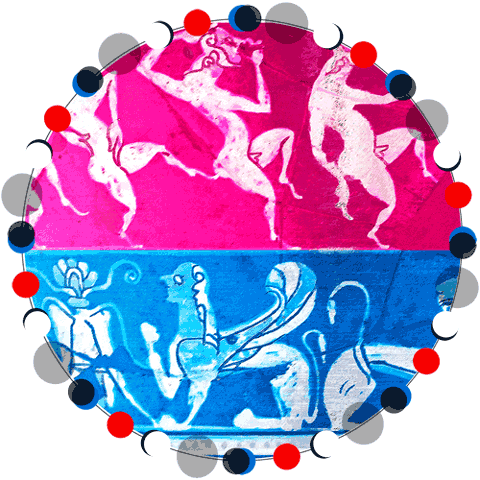

Curated by ZLR Betriebsimperium